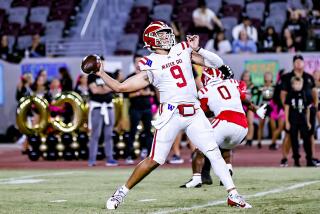Offense Breaking Some New Ground at San Diego State
- Share via
San Diego State is in the running for a bowl bid.
Literally.
The Aztecs are on the move with an in-your-face running attack rather than an in-the-air passing attack. This is as out of character as Madonna playing Miss Daisy.
SDSU, you see, has traditionally approached offensive football as if it’s a trapeze act. The Flying Wallendas spent less time in the air than the Aztec offense. There were astronauts who logged fewer air miles.
Run the ball? Boooorrrriinngg! The Aztecs wanted to be butterflies, not slugs.
Don Coryell figured that he could recruit a quarterback and a few wide receivers and cover weaknesses elsewhere. He wanted a launching pad and a few rockets. His legacy has remained through three decades of aerial acrobatics.
If the Aztecs’ playbook was the size of a telephone directory, running plays might have had the following listing in the index: “See page 237.”
All this has changed under Al Luginbill. He theorizes that, while air power may be flashier and more romantic, the best way to capture and keep turf is with infantry.
Putting this theory in practice, the Aztecs are off to their best start, 6-2, since 1979. With home games upcoming against Wyoming, Colorado State and Brigham Young, they are in the hunt for the Western Athletic Conference championship and in the picture for bowl bids.
“Basically,” Luginbill said, “we want to be a balanced football team. It’s been a gradual process, but I believe you have to run the football to be successful.”
Balance, in the past, meant the Aztecs threw to the left, middle and right an equal number of times. A run, to them, was something the Padres wish they could score.
No longer.
“We’re best,” Luginbill continued, “when we throw 35 to 40 times a game and run about the same amount of time. I’d like to average 175 to 200 yards rushing and 250 to 300 yards passing. If we do that, we’re consistently moving the football.”
What the Aztecs have done, thus far, is average 221.5 yards per game rushing and 245.3 yards per game passing. The passing attack has produced slightly less than projected, but the running attack, of all things, has more than made up the difference.
To underscore the balance that is making 1991 a special season, look at 1990’s numbers: 371.4 yards per game passing to 155.4 yards per game rushing. The ratio has been 2 to 1, passing over rushing, seemingly forever at SDSU.
This new way to go seems to get there much more efficiently and consistently.
Of course, balance is more easily achieved with talent such as Marshall Faulk carrying the football. This kid came out of Louisiana and gained an NCAA record 386 yards in his second collegiate game.
Indeed, handing the ball to Faulk has been a more reliable mode of transportation than throwing it to anyone else. He has gained 7.9 yards per rush. The passing attack has generated 7.01 yards per attempt. There cannot be many backs in history who have averaged more yards per carry than their teams have gained per pass.
In truth, there is much more to SDSU’s running attack than Faulk. To begin with, he was not even the starter at the opening of the season. T.C. Wright was, and he went more than 100 yards in the season opener. To continue, Faulk has missed the past two weeks because of injuries and Wayne Pittman, like Faulk a true freshman, has put together games of 149 and 153 rushing yards.
There may, in fact, be much more to SDSU’s new-found emphasis on running than mere running backs, albeit the ones they have are very talented.
The offensive line has had to make a transition from the more passive approach associated with pass blocking to the smash-face attitude associated with run blocking.
“We have a bunch of guys with defensive temperaments playing the offensive line,” Luginbill said. “We want our offensive lineman to have mean temperaments. We want them to be physical and hard-nosed. We want that to be the reputation of our offensive line.”
Bret Ingalls, the offensive line coach, was not sure what his boss meant about mean.
“My emphasis,” he said, “is on aggressiveness. We want to be able to knock people off the ball. We don’t want to just block ‘em. We want to finish the blocks. We want our guys to finish a block and know the guy’s not going to be a part of making the tackle.”
Two of the offensive linemen, Jim Jennings and Kevin Macon, appreciate what it’s like to follow a strong block, because both of them came to SDSU as running backs. Another, Tony Nichols, is a third-year starter. Carlson Leomiti, a 6-3, 340-pounder, could probably block a tank.
With these guys knocking people around and guys like Faulk carrying the ball, the Aztecs actually use their passing attack for a change of pace rather than as a way of life.
If these Aztecs make it to a bowl game, and they are certainly headed in that direction, they won’t get there with fancy passing. They’ll come crashing through the front door.
More to Read
Go beyond the scoreboard
Get the latest on L.A.'s teams in the daily Sports Report newsletter.
You may occasionally receive promotional content from the Los Angeles Times.










